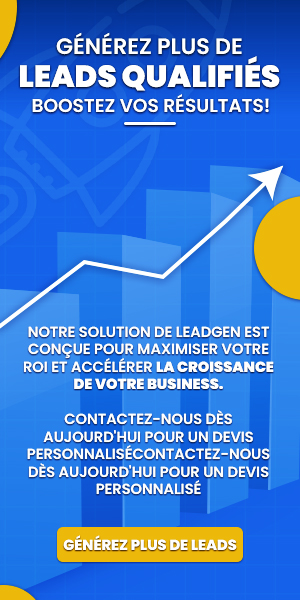In the competitive world of modern marketing, a campaign lead generation stands out as an essential lever for strengthening the effectiveness of marketing strategies. By attracting targeted prospects and converting them into potential customers, this approach not only increases the volume of qualified leads, but also to optimize the return on investment. By integrating appropriate techniques and continually analyzing performance, companies can improve their visibility in the market and boost their growth by transforming strangers into loyal customers.

In a world where digital marketing is constantly evolving, lead generation emerges as a central element for companies wishing to increase their customer base. A lead generation campaign, when well orchestrated, can radically transform your marketing strategy. By attracting qualified leads, engaging them with relevant content, and optimizing their purchasing journey, businesses are better equipped to convert these leads into loyal customers.
Table des matières
ToggleDefine a lead generation campaign
A lead generation campaign involves using various techniques and tools to attract potential prospects and convert them into leads. This includes strategies like content marketing, online advertising, SEO, and email campaigns. The goal is to generate interest and encourage users to provide their contact information. By establishing touchpoints, businesses can take the first step toward lasting customer relationships.
Attract a targeted audience
One of the main benefits of a lead generation campaign is its ability to specifically target an audience. Thanks to precise selection criteria, companies can address market segments that directly correspond to their products or services. This personalized approach optimizes marketing resources and ensures that the effort deployed generates potentially interested prospects.
Use of analytical tools
By integrating analytical tools, it is possible to continually refine the lead generation campaign. These tools provide valuable data on user behavior, allowing you to adjust messages, identify the best performing channels and evaluate the effectiveness of each strategy implemented. Therefore, in-depth analysis becomes an essential lever to improve campaign performance.
Lead engagement and conversion
Having a large number of leads is not enough; it is crucial to effectively engage these prospects. This can be done through informative content adapted to each stage of the customer journey. E-books, webinars, newsletters and case studies are all tools that help educate prospects and establish a relationship of trust. By building a solid relationship based on the value provided, businesses increase their chances of conversions.
Improve the sales cycle
An effective lead generation campaign optimizes the sales cycle by increasing conversion rate. The leads generated are often more qualified, having already expressed an interest in the products or services. This reduces the time it takes to convert them into customers and increases the efficiency of sales teams. Each lead with relevant information about their needs and interests allows salespeople to tailor their approach in a more targeted way.
Lead tracking and nurturing
THE lead nurturing is an integral part of lead generation. It involves nurturing a relationship with prospects over time, even if they are not immediately ready to buy. Through regular, segmented communications, businesses can keep their brand top of mind and prepare them for future conversion. This is particularly essential in long sales cycles where decision-making can take time.
In short, a lead generation campaign can transform your marketing strategy by allowing you to attract, engage and convert prospects more effectively. Through the use of targeted techniques, analytical tools and nurturing strategies, it is possible to optimize each stage of the customer journey. By integrating these elements into your marketing approach, you increase your chances of success and establish a solid customer base, conducive to the growth of your business.
🚀 Maximisez la génération de leads en utilisant une approche de ciblage basée sur l'intention et en exploitant le contenu déjà disponible. Téléchargez notre eBook pour des stratégies clés ! 📊💡 #GénérationDeLeads #CiblageIntention #MarketingB2Bhttps://t.co/0iU9CBQ6m5
— TechTarget FR (@TechTargetFR) February 16, 2024












